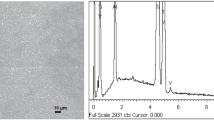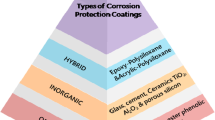Abstract
316L stainless steel (SS) implants suffer from tribological and biocompatibility problems which limit their service lifetime. In order to improve the surface properties of 316L SS for orthopedic implant applications, hard chromium oxide coatings were applied on 316L SS substrates using a reactive magnetron sputtering technique. The morphological, structural, and phase compositional analyses were conducted on the deposited coatings by scanning electron microscopy, X-ray diffraction, Raman spectroscopy, and X-ray photoelectron spectroscopy. The Rockwell-C indentation tests were performed on the coated substrates to qualitatively evaluate the adhesion of coatings on the steel substrates. The surface characteristics of coatings were measured by using an optical profilometer. The mechanical properties of coatings were reported by measuring the Hardness and Young’s modulus. The corrosion resistance of coated and uncoated SS substrates was compared using potentiodynamic polarization tests. An inductively coupled plasma optical emission spectrometry (ICP-OES) was employed to analyze the biocompatibility of the samples by measuring the amount of toxic Cr ions released after the immersion test. The results show that the coatings are adherent and composed of a single Cr2O3 phase with a hardness of 25 to 29 GPa. The corrosion resistance of the SS has been improved by applying a chromium oxide coating. The coated SS samples have also demonstrated better wear resistance and lower friction coefficient compared to bare SS samples under a reciprocating sliding condition in saline solution. The biocompatibility of the SS has been enhanced by the Cr2O3 coating as much less Cr ions were released after immersion tests. These results indicate that the hard Cr2O3 coatings can be considered as a candidate for extending the lifetime of SS implants.







Similar content being viewed by others
References
Ağaoğlu G, Arun T, Izgi B et al (2001) Nickel and chromium levels in the saliva and serum of patients with fixed orthodontic appliances. Angle Orthod 71:375–379. https://doi.org/10.1043/0003-3219(2001)071<0375:NACLIT>2.0.CO;2
Anttila A, Lappalainen R, Heinonen H, Santavirta SKY (1999) Superiority of diamond-like carbon coating on articulating surfaces of artificial hip joints. New Diam Front Carbon Technol 9:283–288
ASTM G5 (2015) Standard reference test method for making potentiodynamic anodic polarization measurements. 1–9. https://doi.org/10.1520/G0005-14.2
Babu PS, Sen D, Jyothirmayi A, Krishna LR, Rao DS (2018) Influence of microstructure on the wear and corrosion behavior of detonation sprayed Cr2O3-Al2O3 and plasma sprayed Cr2O3 coatings. Ceram Int 44:2351–2357. https://doi.org/10.1016/j.ceramint.2017.10.203
Barshilia HC, Rajam KS (2008) Growth and characterization of chromium oxide coatings prepared by pulsed-direct current reactive unbalanced magnetron sputtering. Appl Surf Sci 255:2925–2931. https://doi.org/10.1016/j.apsusc.2008.08.057
Bhushan B (1981) Structural and compositional characterization of Rf sputter-deposited Ni-Cr+Cr2O3 films. J Lubr Technol ASME 103:211–217
Bhushan B, Theunissen GSAM, Li XD (1997) Tribological studies of chromium oxide films for magnetic recording applications. Thin Solid Films 311:67–80. https://doi.org/10.1016/S0040-6090(97)00453-7
Brown DA, Cunningham D, Glass WK (1968) The infrared and Raman spectra of chromium (III) oxide. Spectrochim Acta A Mol Spectrosc 24:965–968. https://doi.org/10.1016/0584-8539(68)80115-1
BS EN1071-12 (2010) Advanced technical ceramics. Methods of test for ceramic coatings. Reciprocating wear test
Carta G, Natali M, Rossetto G, Zanella P, Salmaso G, Restello S, Rigato V, Kaciulis S, Mezzi A (2005) A comparative study of Cr2O3 thin films obtained by MOCVD using three different precursors. Chem Vap Depos 11:375–380. https://doi.org/10.1002/cvde.200406360
Charalambous CP (2014) Calcium phosphate ceramics as hard tissue prosthetics. In: Classic papers in orthopaedics. Springer London, London, pp 419–421
Contoux G, Cosset F, Célérier A, Machet J (1997) Deposition process study of chromium oxide thin filmsobtained by d.c. magnetron sputtering. Thin Solid Films 292:75–84. https://doi.org/10.1016/S0040-6090(96)08941-9
Da-Yung Wang M-CC (2001) Characterization of Cr2O3/CrN duplex coatings for injection molding applications. Surf Coat Technol 137:164–169. https://doi.org/10.1016/j.jmmm.2003.12.245
Díaz M, Sevilla P, Galán AM, Escolar G, Engel E, Gil FJ (2008) Evaluation of ion release, cytotoxicity, and platelet adhesion of electrochemical anodized 316 L stainless steel cardiovascular stents. J Biomed Mater Res Appl Biomater 87B:555–561. https://doi.org/10.1002/jbm.b.31144
Dong S, Song B, Hansz B, Liao H, Coddet C (2013) Microstructure and properties of Cr2O3 coating deposited by plasma spraying and dry-ice blasting. Surf Coat Technol 225:58–65. https://doi.org/10.1016/j.surfcoat.2013.03.016
Kaufmann EN (2003) Raman spectroscopy of solids. In: Characterization of materials. John Wiley & Sons, Inc, pp 698–700
Fisher J, Hu XQ, Stewart TD, Williams S, Tipper JL, Ingham E, Stone MH, Davies C, Hatto P, Bolton J, Riley M, Hardaker C, Isaac GH, BERRY G (2004) Wear of surface engineered metal-on-metal hip prostheses. J Mater Sci Mater Med 15:225–235. https://doi.org/10.1023/B:JMSM.0000015482.24542.76
Fisher J, Hu XQ, Tipper JL, Stewart TD, Williams S, Stone MH, Davies C, Hatto P, Bolton J, Riley M, Hardaker C, Isaac GH, Berry G, Ingham E (2002) An in vitro study of the reduction in wear of metal-on-metal hip prostheses using surface-engineered femoral heads. Proc Inst Mech Eng H J Eng Med 216:219–230. https://doi.org/10.1243/09544110260138709
Gotman I, Gutmanas EY (2014) Titanium nitride-based coatings on implantable medical devices. Adv Biomater Devices Med 1:53–73
Hones P, Diserens M, Lévy F (1999) Characterization of sputter-deposited chromium oxide thin films. Surf Coatings Technol 120–121:277–283. https://doi.org/10.1016/S0257-8972(99)00384-9
ISO 14577-1 (2015) Metallic materials-instrumented indentation test for hardness and materials parameters-test method
ISO 26443 (2002) Fine ceramics (advanced ceramics, advanced technical ceramics) — rockwell indentation test for evaluation of adhesion of ceramic coatings
Ji AL, Wang W, Song G et al (2004) Microstructures and mechanical properties of chromium oxide films by arc ion plating. Mater Lett 58:1993–1998. https://doi.org/10.1016/j.matlet.2003.12.029
Jianjun W, Xue Q, Wang H (1992) Friction and wear of Cr203 coating in inorganic salt solutions. Wear 152:161–170
Kainarskii IS, Degtyareva EV (1977) Chromic oxide as refractory material. Refractories 18:42–47. https://doi.org/10.1007/BF01319646
Kao AS, Doerner MF, Novotny VJ (1989) Processing effects on the tribological characteristics of reactively sputtered chromium oxide (Cr2O3) overcoat films. J Appl Phys 66:5315–5321. https://doi.org/10.1063/1.343722
Kikuchi S, Kawauchi K, Kurosawa M et al (2005) Non-destructive rapid analysis discriminating between chromium(VI) and chromium(III) oxides in electrical and electronic equipment using Raman spectroscopy. Anal Sci 21:197–198. https://doi.org/10.2116/analsci.21.197
Kocadereli L, Ataç PA, Kale PS, Ozer D (2000) Salivary nickel and chromium in patients with fixed orthodontic appliances. Angle Orthod 70:431–434. https://doi.org/10.1043/0003-3219(2000)070<0431:SNACIP>2.0.CO;2
Lackey WJ, Stinton DP, Cerny GA et al (1987) Ceramic coatings for advanced heat engines—A review and projection. Adv Ceram Mater 2:24–30. https://doi.org/10.1111/j.1551-2916.1987.tb00048.x
Li G, Evitts R, Boulfiza M, Li ADS (2018) A customized Python module for interactive curve fitting on potentiodynamic scan data. https://zenodo.org/record/1343975#.W6FZvc5KjIU
Lin J, Sproul WD (2015) Structure and properties of Cr2O3 coatings deposited using DCMS, PDCMS, and DOMS. Surf Coat Technol 276:70–76. https://doi.org/10.1016/j.surfcoat.2015.06.044
Liu H, Tao J, Xu J, Chen Z, Gao Q (2009) Corrosion and tribological behaviors of chromium oxide coatings prepared by the glow-discharge plasma technique. Surf Coat Technol 204:28–36. https://doi.org/10.1016/j.surfcoat.2009.06.020
Love CA, Cook RB, Harvey TJ, Dearnley PA, Wood RJK (2013) Diamond like carbon coatings for potential application in biological implants—a review. Tribol Int 63:141–150. https://doi.org/10.1016/J.TRIBOINT.2012.09.006
Luo F, Gao K, Pang X, Yang H, Qiao L, Wang Y (2008) Characterization of the mechanical properties and failure modes of hard coatings deposited by RF magnetron sputtering. Surf Coat Technol 202:3354–3359. https://doi.org/10.1016/j.surfcoat.2007.12.020
Luo F, Pang X, Gao K, Yang H, Wang Y (2007) Role of deposition parameters on microstructure and mechanical properties of chromium oxide coatings. Surf Coat Technol 202:58–62. https://doi.org/10.1016/j.surfcoat.2007.04.066
Mohammadtaheri M, Yang Q, Li Y, Corona-Gomez J (2018) The effect of deposition parameters on the structure and mechanical properties of chromium oxide coatings deposited by reactive magnetron sputtering. Coatings 8:111. https://doi.org/10.3390/coatings8030111
Monnereau O, Tortet L, Grigorescu CEA et al (2010) Chromium oxides mixtures in PLD films investigated by Raman spectroscopy. J Optoelectron Adv Mater 12:1752–1757
Moulder JF, Stickle WF, Sobol PE, Bomben KD (1992) Handbook of X-ray photoelectron spectroscopy 261. https://doi.org/10.1002/sia.740030412
Ningshen S, Kamachi Mudali U, Amarendra G, Gopalan P, Dayal RK, Khatak HS (2006) Hydrogen effects on the passive film formation and pitting susceptibility of nitrogen containing type 316L stainless steels. Corros Sci 48:1106–1121. https://doi.org/10.1016/j.corsci.2005.05.003
Oje AM, Ogwu AA (2017) Chromium oxide coatings with the potential for eliminating the risk of chromium ion release in orthopaedic implants subject category. R Soc open Sci 4:170218. https://doi.org/10.1098/rsos.170218
Oliver WC, Pharr GM (1992) An improved technique for determining hardness and elastic modulus using load and displacement sensing indentation experiments. Mater Res Soc 7:1564–1583
Pang X, Gao K, Luo F, Yang H, Qiao L, Wang Y, Volinsky AA (2008) Annealing effects on microstructure and mechanical properties of chromium oxide coatings. Thin Solid Films 516:4685–4689. https://doi.org/10.1016/j.tsf.2007.08.083
Roy RK, Lee K-R (2007) Biomedical applications of diamond-like carbon coatings: a review. J Biomed Mater Res B Appl Biomater 83B:72–84. https://doi.org/10.1002/jbm.b.30768
Saeki I, Ohno T, Seto D, Sakai O, Sugiyama Y, Sato T, Yamauchi A, Kurokawa K, Takeda M, Onishi T (2011) Measurement of Young’s modulus of oxides at high temperature related to the oxidation study. Mater High Temp 28:264–268. https://doi.org/10.3184/096034011X13182685579795
Samsonov GV (1973) The oxide handbook. IFI/Plenum press
Santonen T, Stockmann H, ZITTING A (2010) Review on toxicity of stainless steel
Serro AP, Completo C, Colaço R, dos Santos F, da Silva CL, Cabral JMS, Araújo H, Pires E, Saramago B (2009) A comparative study of titanium nitrides, TiN, TiNbN and TiCN, as coatings for biomedical applications. Surf Coat Technol 203:3701–3707. https://doi.org/10.1016/J.SURFCOAT.2009.06.010
Shim S-H, Duffy TS, Jeanloz R, Yoo CS, Iota V (2004) Raman spectroscopy and x-ray diffraction of phase transitions in Cr2O3 to 61 GPa. Phys Rev B 69:144107. https://doi.org/10.1103/PhysRevB.69.144107
Singh VP, Sil A, Jayaganthan R (2012) Wear of plasma sprayed conventional and nanostructured Al2O3 and Cr2O3, based coatings. Trans Indian Inst Metals 65:1–12. https://doi.org/10.1007/s12666-011-0070-0
Sourty E, Sullivan JL, Bijker MD (2003) Chromium oxide coatings applied to magnetic tape heads for improved wear resistance. Tribol Int 36:389–396. https://doi.org/10.1016/S0301-679X(02)00214-1
Sousa PM, Silvestre AJ, Conde O (2011) Cr2O3 thin films grown at room temperature by low pressure laser chemical vapour deposition. Thin Solid Films 519:3653–3657. https://doi.org/10.1016/J.TSF.2011.01.382
Taeger G, Podleska LE, Schmidt B, Ziegler M, Nast-Kolb D (2003) Comparison of diamond-like-carbon and alumina-oxide articulating with polyethylene in total hip arthroplasty. Materwiss Werksttech 34:1094–1100. https://doi.org/10.1002/mawe.200300717
Tromas C, Stinville JC, Templier C, Villechaise P (2012) Hardness and elastic modulus gradients in plasma-nitrided 316L polycrystalline stainless steel investigated by nanoindentation tomography. Acta Mater 60:1965–1973. https://doi.org/10.1016/J.ACTAMAT.2011.12.012
Trube J (1993) Low stress and optically transparent chromium oxide layer for x-ray mask making. J Vac Sci Technol B Microelectron Nanom Struct 11:2990. https://doi.org/10.1116/1.586574
van Hove RP, Sierevelt IN, van Royen BJ, Nolte PA (2015) Titanium-nitride coating of orthopaedic implants: a review of the literature. Biomed Res Int 2015:1–9. https://doi.org/10.1155/2015/485975
Acknowledgments
The authors would like to thank George Belev for performing XPS, Jianfeng Zhu for the grazing incidence XRD measurements, and Gang Li for interpretation of corrosion data.
Funding
This work was financially supported by the Natural Sciences and Engineering Research Council of Canada (NSERC), the Canada Foundation for Innovation (CFI), Western Economic Diversification Canada, and the University of Saskatchewan.
Author information
Authors and Affiliations
Corresponding author
Ethics declarations
Conflict of interest
The authors declare that they have no conflict of interest.
Additional information
Responsible editor: Philippe Garrigues
Publisher’s note
Springer Nature remains neutral with regard to jurisdictional claims in published maps and institutional affiliations.
Rights and permissions
About this article
Cite this article
Mohammadtaheri, M., Li, Y. & Yang, Q. Hard Cr2O3 coatings on SS316L substrates prepared by reactive magnetron sputtering technique: a potential candidate for orthopedic implants. Environ Sci Pollut Res 28, 25146–25154 (2021). https://doi.org/10.1007/s11356-019-05006-3
Received:
Accepted:
Published:
Issue Date:
DOI: https://doi.org/10.1007/s11356-019-05006-3




